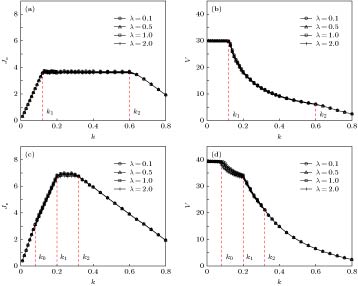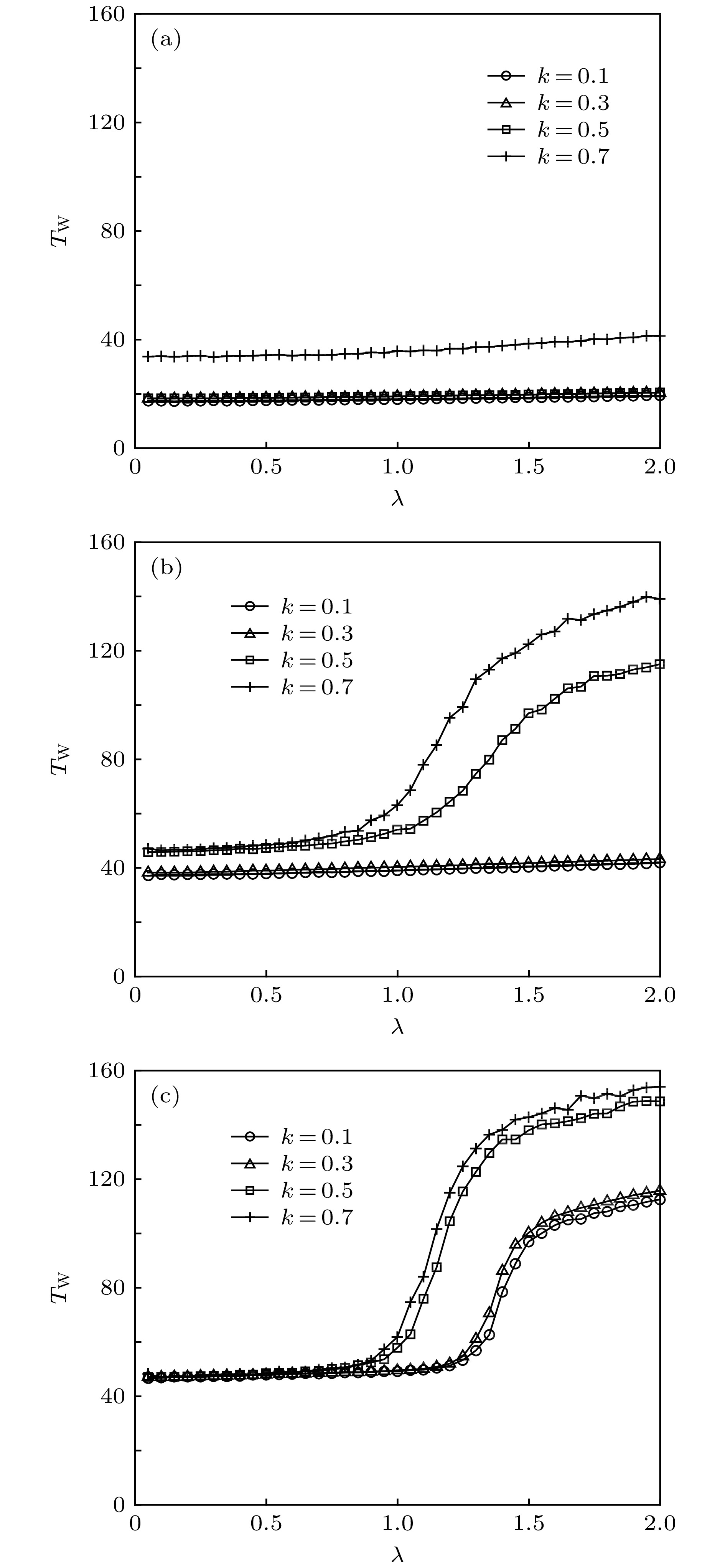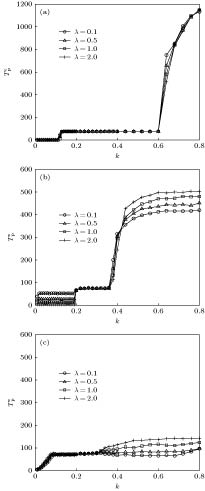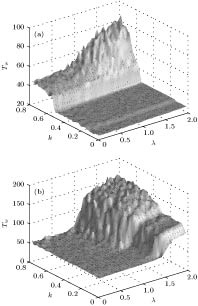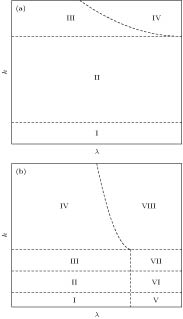-
Interference between pedestrians and motor vehicles at signalized intersections not only leads the traffic to delay and traffic efficiency to decrease, but also induces traffic crashes to happen frequently. In this paper, a microscopic discrete model for traffic flow is adopted to study the mutual interference mechanism between pedestrians and vehicles at signalized intersection. The vehicular traffic flow model is based on the refined NaSch model, and traffic lights are introduced to consider the driver anticipating in traffic signal switching. Based on the multi-step lattice gas model, the pedestrian flow model considers the fact that the pedestrians’ speed increases gradually during pedestrian cross-street green time. Both models reflect real features of movement of vehicles (pedestrians) in daily life. When the traffic light signal switches, the vehicles (pedestrians) staying in the conflict area result in the delay of pedestrians (vehicles). It is assumed that pedestrians and vehicles cannot coexist in the conflict area at the same time. In the simulation, the periodic boundary condition is applied to the lane, and the open boundary condition is applied to the crosswalk. The arrival rate of pedestrian is assumed to satisfy the Poisson distribution. Both the fundamental diagram of vehicular traffic flow and the pedestrian waiting time are calculated, and the phase diagram revealing the global nature of the presented model is obtained accordingly. The quantitative characteristics of vehicle (pedestrian) delay time caused by pedestrians (vehicles) staying in the conflict area are given as well. Simulation results show that there is a critical split. When the split is less than the critical value, three kinds of traffic phases, i.e., free flow phase, saturated flow phase, and jamming flow phase, appear with the increase of density. When the split is larger than the critical value, four kinds of traffic phases, i.e., free flow phase, coexisting phase, saturated flow phase, and jamming flow phase are distinguished. The delay caused by the mutual interference between pedestrians and motor vehicles is closely related to the state of vehicle flow and the state of pedestrian flow. When the arrival rate of pedestrians is quite large and the split is large enough, these pedestrians in the waiting area cannot be emptied once in a single pedestrian cross-street cycle. The qualitative and quantitative characteristics of mutual interference between pedestrians and vehicles are discussed in more detail. The setting of a reasonable split not only ensures the efficiency of traffic flow, but also reduces the waiting time of pedestrians to cross the street.
-
Keywords:
- cellular automata /
- lattice gas model /
- pedestrian-vehicle interference /
- delay
[1] Lam W H K, Lee J Y S, Cheung C Y 2002 Transportation 29 169
 Google Scholar
Google Scholar
[2] 李文勇, 陈学武, 王庆, 李娜 2006 武汉理工大学学报 (交通科学与工程版) 30 751
Li W Y, Chen X W, Wang Q, Li N 2006 J. Wuhan Univ. Tech. (Transp. Sci. & Eng.) 30 751
[3] Guo Y Y, Sayed T, Zaki M H 2017 IET Intell. Transp. Sy. 11 28
 Google Scholar
Google Scholar
[4] Biswas S, Ghosh I, Chandra S 2017 Transp. Dev. Econ. 3 2
 Google Scholar
Google Scholar
[5] Zhang Y H, Mamun S A, Ivan J N, Ravishanker N, Haque A 2015 Accident Anal. Prev. 83 26
 Google Scholar
Google Scholar
[6] Ni Y, Wang M L, Sun J, Li K P 2016 Accident Anal. Prev. 96 118
[7] Lee J Y S, Lam W H K 2008 Transp. Res. A 42 1314
[8] Li X, Dong L Y 2012 Chin. Phys. Lett. 29 098902
 Google Scholar
Google Scholar
[9] Li S S, Qian D L, Luo U 2012 J. Cent. South Univ. 19 3351
 Google Scholar
Google Scholar
[10] Zeng W L, Chen P, Nakamura H, Tryo-Asano M 2014 Transp. Res. C 40 143
 Google Scholar
Google Scholar
[11] Lu L L, Ren G, Wang W, Chan C Y 2015 Transp. Res. A 80 76
[12] Belbasi S, Foulaadvand M E 2008 J. Stat. Mech. 2008 P07021
[13] Myozin S 1965 T. Jpn. Soc. Civil Eng. 1965 42
[14] Xie D F, Zhao X M, Li X G 2015 Int. J. Mod. Phys. C 26 1550019
 Google Scholar
Google Scholar
[15] Zeng J W, Yu S B, Qian Y S, Wei X T, Feng X, Wang H 2017 Mod. Phys. Lett. B 31 1750238
[16] Helbing D, Jiang R, Treiber M 2005 Phys. Rev. E 72 046130
 Google Scholar
Google Scholar
[17] Muramatsu M, Irie T, Nagatani T 1999 Physica A 267 487
 Google Scholar
Google Scholar
[18] Bando M, Hasebe K, Nakayama A, Shibata A, Sugiyama Y 1995 Phys. Rev. E 51 1035
 Google Scholar
Google Scholar
[19] Nagel K, Schreckenberg M 1992 J. Phys. I (France) 2 2221
 Google Scholar
Google Scholar
[20] Blue V J, Adler J L 2001 Transp. Res. B 35 293
 Google Scholar
Google Scholar
[21] Barlovic R, Santen L, Schadschneider A, Schreckenberg M 1998 Eur. Phys. J. B 5 793
 Google Scholar
Google Scholar
[22] Zhang U, Duan H L, Zhang Y 2007 Tsinghua Sci. Technol. 12 214
 Google Scholar
Google Scholar
[23] Guo R Y, Guo X 2011 Chin. Phys. Lett. 28 118903
 Google Scholar
Google Scholar
[24] Xie D F, Gao Z Y, Zhao X M, Wang Z W 2012 J. Transp. Eng. 138 1442
 Google Scholar
Google Scholar
[25] Li X M, Yan X D, Li X G, Wang J F 2012 Discrete Dyn. Nat. Soc. 2012 287502
[26] 孙泽, 贾斌 2012 61 100508
 Google Scholar
Google Scholar
Sun Z, Jia B 2012 Acta Phys. Sin. 61 100508
 Google Scholar
Google Scholar
[27] 余艳, 白克钊, 孔令江 2013 广西师范大学学报(自然科学版) 31 6
Yu Y, Bai K Z, Kong L J 2013 J. Guangxi Normal Univ. (Nat. Sci. Ed.) 31 6
[28] Guo R Y, Lu X S 2016 J. Syst. Sci. Complex 29 202
 Google Scholar
Google Scholar
[29] Li X, Sun J Q 2016 Physica A 460 335
 Google Scholar
Google Scholar
[30] Echab H, Ez-Zahraouy H, Lakouari N 2016 Physica A 461 854
 Google Scholar
Google Scholar
[31] Deb S, Strawderman L J, Carruth D W 2018 Transp. Res. F 59 135
 Google Scholar
Google Scholar
[32] 陈然, 李翔, 董力耘 2012 61 144502
 Google Scholar
Google Scholar
Chen R, Li X, Dong L Y 2012 Acta Phys. Sin. 61 144502
 Google Scholar
Google Scholar
[33] 马新露, 孙惠芳 2014 交通运输系统工程与信息 8 59
 Google Scholar
Google Scholar
Ma X L, Sun H F 2014 J. Transp. Syst. Eng. Info. Tech. 8 59
 Google Scholar
Google Scholar
-
图 2 不同绿信比下车辆运动基本图 (a)流量-密度曲线(μ = 0.5); (b)速度-密度曲线(μ = 0.5); (c)流量-密度曲线(μ = 0.9); (d)速度-密度曲线(μ = 0.9)
Figure 2. Fundamental diagrams for vehicles under different splits: (a) Flux-density relation (μ = 0.5); (b) speed-density relation (μ = 0.5); (c) flux-density relation (μ = 0.9); (d) speed-density relation (μ = 0.9).
表 1 各种情况下行人向邻近元胞的行走概率
Table 1. Probabilities for a pedestrian to move towards his/her neighboring cells
${S_i}$ (0, 0, 0) (1, 0, 0) (0, 0, 1) (0, 1, 0) (1, 0, 1) (0, 1, 1) (1, 1, 0) (1, 1, 1) ${p_{\rm{L}}}$ $\dfrac{{1 - p}}{3}$ 0 $\dfrac{{1 - p}}{2}$ 1/2 0 1 0 0 ${p_{\rm{F}}}$ $p + \dfrac{{1 - p}}{3}$ $p + \dfrac{{1 - p}}{2}$ $p + \dfrac{{1 - p}}{2}$ 0 1 0 0 0 ${p_{\rm{R}}}$ $\dfrac{{1 - p}}{3}$ $\dfrac{{1 - p}}{2}$ 0 1/2 0 0 1 0 -
[1] Lam W H K, Lee J Y S, Cheung C Y 2002 Transportation 29 169
 Google Scholar
Google Scholar
[2] 李文勇, 陈学武, 王庆, 李娜 2006 武汉理工大学学报 (交通科学与工程版) 30 751
Li W Y, Chen X W, Wang Q, Li N 2006 J. Wuhan Univ. Tech. (Transp. Sci. & Eng.) 30 751
[3] Guo Y Y, Sayed T, Zaki M H 2017 IET Intell. Transp. Sy. 11 28
 Google Scholar
Google Scholar
[4] Biswas S, Ghosh I, Chandra S 2017 Transp. Dev. Econ. 3 2
 Google Scholar
Google Scholar
[5] Zhang Y H, Mamun S A, Ivan J N, Ravishanker N, Haque A 2015 Accident Anal. Prev. 83 26
 Google Scholar
Google Scholar
[6] Ni Y, Wang M L, Sun J, Li K P 2016 Accident Anal. Prev. 96 118
[7] Lee J Y S, Lam W H K 2008 Transp. Res. A 42 1314
[8] Li X, Dong L Y 2012 Chin. Phys. Lett. 29 098902
 Google Scholar
Google Scholar
[9] Li S S, Qian D L, Luo U 2012 J. Cent. South Univ. 19 3351
 Google Scholar
Google Scholar
[10] Zeng W L, Chen P, Nakamura H, Tryo-Asano M 2014 Transp. Res. C 40 143
 Google Scholar
Google Scholar
[11] Lu L L, Ren G, Wang W, Chan C Y 2015 Transp. Res. A 80 76
[12] Belbasi S, Foulaadvand M E 2008 J. Stat. Mech. 2008 P07021
[13] Myozin S 1965 T. Jpn. Soc. Civil Eng. 1965 42
[14] Xie D F, Zhao X M, Li X G 2015 Int. J. Mod. Phys. C 26 1550019
 Google Scholar
Google Scholar
[15] Zeng J W, Yu S B, Qian Y S, Wei X T, Feng X, Wang H 2017 Mod. Phys. Lett. B 31 1750238
[16] Helbing D, Jiang R, Treiber M 2005 Phys. Rev. E 72 046130
 Google Scholar
Google Scholar
[17] Muramatsu M, Irie T, Nagatani T 1999 Physica A 267 487
 Google Scholar
Google Scholar
[18] Bando M, Hasebe K, Nakayama A, Shibata A, Sugiyama Y 1995 Phys. Rev. E 51 1035
 Google Scholar
Google Scholar
[19] Nagel K, Schreckenberg M 1992 J. Phys. I (France) 2 2221
 Google Scholar
Google Scholar
[20] Blue V J, Adler J L 2001 Transp. Res. B 35 293
 Google Scholar
Google Scholar
[21] Barlovic R, Santen L, Schadschneider A, Schreckenberg M 1998 Eur. Phys. J. B 5 793
 Google Scholar
Google Scholar
[22] Zhang U, Duan H L, Zhang Y 2007 Tsinghua Sci. Technol. 12 214
 Google Scholar
Google Scholar
[23] Guo R Y, Guo X 2011 Chin. Phys. Lett. 28 118903
 Google Scholar
Google Scholar
[24] Xie D F, Gao Z Y, Zhao X M, Wang Z W 2012 J. Transp. Eng. 138 1442
 Google Scholar
Google Scholar
[25] Li X M, Yan X D, Li X G, Wang J F 2012 Discrete Dyn. Nat. Soc. 2012 287502
[26] 孙泽, 贾斌 2012 61 100508
 Google Scholar
Google Scholar
Sun Z, Jia B 2012 Acta Phys. Sin. 61 100508
 Google Scholar
Google Scholar
[27] 余艳, 白克钊, 孔令江 2013 广西师范大学学报(自然科学版) 31 6
Yu Y, Bai K Z, Kong L J 2013 J. Guangxi Normal Univ. (Nat. Sci. Ed.) 31 6
[28] Guo R Y, Lu X S 2016 J. Syst. Sci. Complex 29 202
 Google Scholar
Google Scholar
[29] Li X, Sun J Q 2016 Physica A 460 335
 Google Scholar
Google Scholar
[30] Echab H, Ez-Zahraouy H, Lakouari N 2016 Physica A 461 854
 Google Scholar
Google Scholar
[31] Deb S, Strawderman L J, Carruth D W 2018 Transp. Res. F 59 135
 Google Scholar
Google Scholar
[32] 陈然, 李翔, 董力耘 2012 61 144502
 Google Scholar
Google Scholar
Chen R, Li X, Dong L Y 2012 Acta Phys. Sin. 61 144502
 Google Scholar
Google Scholar
[33] 马新露, 孙惠芳 2014 交通运输系统工程与信息 8 59
 Google Scholar
Google Scholar
Ma X L, Sun H F 2014 J. Transp. Syst. Eng. Info. Tech. 8 59
 Google Scholar
Google Scholar
Catalog
Metrics
- Abstract views: 9356
- PDF Downloads: 100
- Cited By: 0















 DownLoad:
DownLoad:
